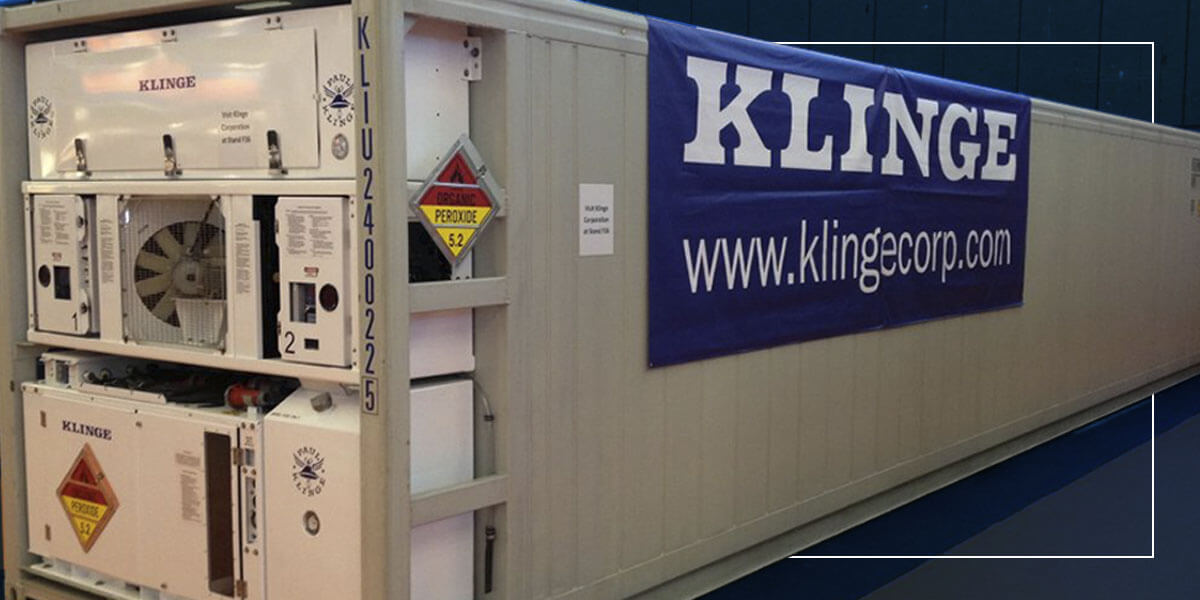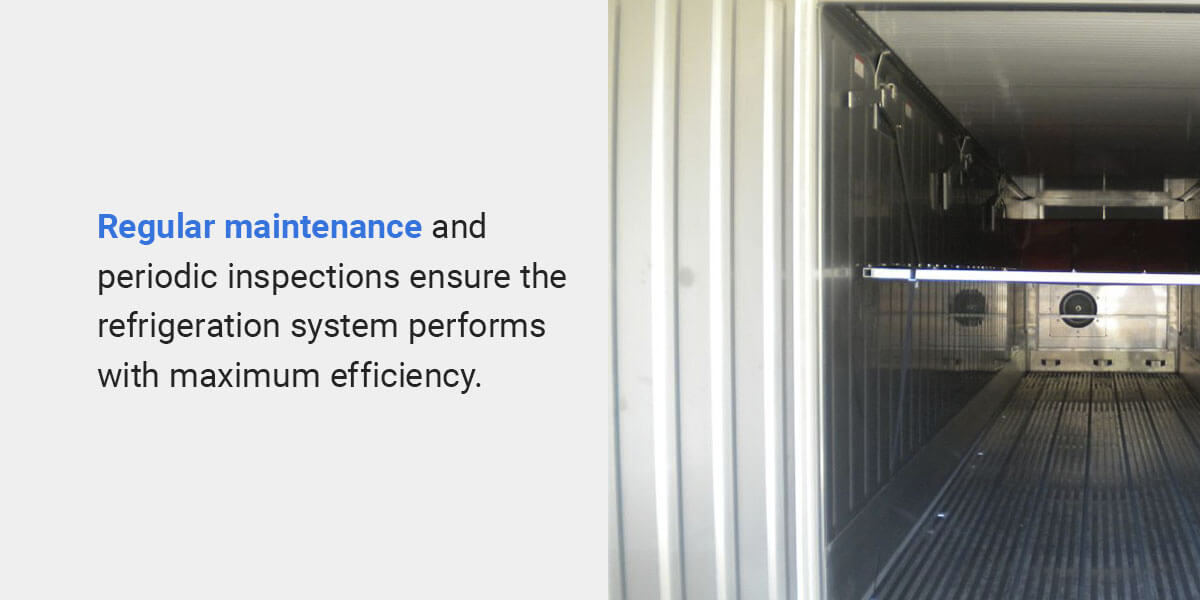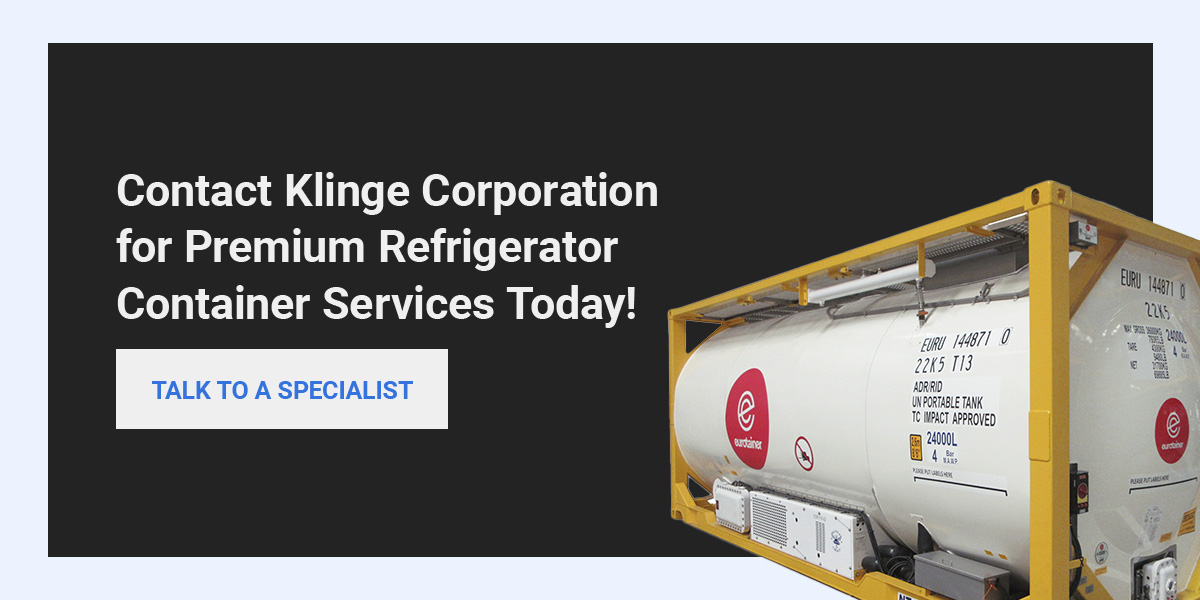If you own refrigerated containers, you understand that complete replacements can cost thousands of dollars. This is why regular and proper container maintenance and repairs are so crucial. Besides eliminating stress, well-planned maintenance saves money, improves your brand’s reputation and allows you to serve your clients as expected.
Learning about the vital components of reefer containers, the types of damages, the common repairs conducted on reefer containers and how to perform emergency repairs can go a long way to keep your processes moving efficiently.
What Are the Basic Components of a Reefer Container?
Reefers have multiple sections that allow them to create the ideal environment for your cargo with the help of several components, including:
- Controller: A reefer container’s controller system adjusts the reefer’s internal atmosphere. It allows you to control the alarm conditions and temperature setpoint, and humidity required to keep the goods in peak condition.
- Compressor: The compressor plays a pivotal role in a refrigeration container system — it’s the first step in the refrigeration cycle and the heart of the reefer unit. As indicated by the name, the compressor “compresses” the low-pressure superheated gas, changing it to a high-pressure gas to start the refrigeration cycle.
- Condenser and Condenser Fans: Condensers cool the gas from the compressor through a heat exchange process. As the condenser fans move air over the condenser coil, heat from the gas is rejected and the refrigerant loses temperature. The cooling refrigerant condenses, and the hot gas becomes a high-pressure, sub-cooled liquid.
- Expansion Valve: The high-pressure, sub-cooled liquid passes through a thermal expansion valve into a low-pressure environment, turning it into vapor. .
- Evaporator, Evaporator Fans, and Heaters: The vapor travels into the evaporator and absorbs heat from the cargo area as the evaporator fans facilitate proper airflow over the coil and air distribution in the container. This allows the system to reach and maintain the appropriate temperature and reduce relative humidity. Where the reefer needs warm air to retain a consistent interior temperature, this is achieved via hot gas or electrical heating
Besides these standard components, there are others specific to the design and type of reefer. For example, some reefers have remote monitoring and management systems that allow you to monitor and control the temperature, humidity, oxygen and carbon dioxide levels. Learning about the various parts of the container you use and how its functions help with troubleshooting and maintenance is important.
Why Give Your Reefer Containers Regular Maintenance Breaks?
Preventive maintenance helps you mitigate the risk of unexpected failures, which can result in loss of money, waste your time and cause damage to sensitive products. It enables your units to perform optimally, allowing you to deliver goods as scheduled. Consequently, it enhances your brand’s reputation and helps you comply with regulatory requirements.
Reefers perform a fundamental role in the cold chain logistics or shipping process. They’re used in various industrial applications to transport and store food, biological samples, drugs and pharmaceutical products and chemicals.
Transporting these products may require you to maintain steady temperatures between -20° and 25° Celsius (-4° to 77° Fahrenheit) or level at ultra-low temperatures at -70° Celsius (-94° Fahrenheit). A minor temperature fluctuation can cause damage to the cargo.
Regular maintenance and periodic inspections ensure the refrigeration system performs with maximum efficiency. Additionally, giving your reefer containers frequent maintenance breaks allows you to plan your expenses rather than encountering unplanned costs.
While securing extra parts and scheduling regular maintenance is an investment, it saves money in the long term. It’s relatively less expensive to conduct routine maintenance and inspections than to replace the entire unit or a substantial part of it. Preventive maintenance is a sure way to increase your return on investment.
What Are the Typical Types of Reefer Damage?
The five types of typical damages that can occur on reefer containers include:
- Physical damage: Physical damage may result from knocks and bumps, most often during the loading and unloading process. Proper dunnage and lashing keep the cargo intact and minimize impacts during shipping. Additionally, adequate weight distribution improves stability, which protects rolls and falls.
- Infestation damage: Rodents, pests and insects may infest your container, especially if a container is inadequately cleaned and maintained. These animals pose significant threats to the cargo, primarily in agricultural products. Regularly cleaning and inspecting your reefers reduces the hours and costs you’d incur due to inspections by port authorities.
- Contamination damage: Reefers containing different chemical products may spill or become exposed. Moreover, improper cleaning can cause months and years of pollutants to accumulate in various areas of the container. Regular and proper cleaning makes container contents in this sense suitable and hygienic for industrial usage.
- Water and salt air damage: Refrigerated containers are exposed to harsh weather conditions, seawater ingress, and salty and humid atmosphere, mainly when transported by sea through different climate regions. This kind of environment causes rust, creating holes in the containers and damaging the sealing gaskets. Regular maintenance, such as coating and washing the reefers, can increase their life span.
- Component damage: The various parts of reefers may get damaged due to sudden power failure, improper maintenance, inadequate temperature controls and equipment mishandling. When the vital components fail, the reefer container can’t perform optimally. Handling the unit with care and replacing broken parts on time helps your reefer last longer.
What Are the Common Kinds of Reefer Refrigeration Repairs and Maintenance?
Now that you know how important regular maintenance is to your operations, you should understand how to properly care for your containers. Some common kinds of refrigerated shipping container repairs and maintenance include:
1. Removing Rust
Reefers are constantly exposed to the elements. Harsh weather conditions on land or at sea can cause reefer containers to corrode and create holes in the walls. In such situations, rust removal may be necessary.
Sandblasting is an effective and standard cleaning method to remove rust from metals. It involves using an air compressor to propel blast abrasive grains through a nozzle at high velocity. This process causes the rust to break down and come off. Sandblasting is appropriate for surface-level rust.
If the rust is buried underneath the paint, you may need to cut out the area and weld it with a new piece of steel.
2. Fixing Leaks, Cracks and Holes
Holes and cracks are access routes for rodents and bugs. After treating your reefer container with pesticides, identify every opening and cure them. Patch the holes and fill the cracks by welding those areas. When the holes are significant, it may be appropriate to replace the container.
Over longer periods of time and due to rough handling, leaks may also occur in the reefer system. Broken or leaking piping decrease the system’s efficiency, sometimes leading to unit failure, and pose health challenges. Checking the reefer containers and reefer units regularly for cracks and wear is advisable.
3. Repairing the Floor of the Container
Continuous loading and unloading of cargo in the container scrapes, scratches and dents the aluminum flooring. Be sure to inspect the floor regularly in your containers and repair it when necessary.
4. Replacing the Door Seals
An essential function of refrigeration containers is maintaining stable temperatures. Their unique design allows you to control airflow and prevent unwanted elements from entering.
Door seals are fundamental in keeping containers watertight and airtight. However, with time, the rubber seal deteriorates. The best and most straightforward solution is to replace the seals with new ones before they wear out completely.
5. Repainting the Body
Paint creates an extra layer of protection for containers and prevents direct contact with the elements. Reapply paint regularly to retain its effectiveness. Minor dents can cause paint to chip away and make it vulnerable to rust, so keep an eye out for those.
How Do You Conduct Emergency Refrigeration Container Repairs?
Generally, it’s best to contact an experienced service technician to repair your reefer containers. However, in the case of an emergency when you’re faced with a leak, the following tips may be helpful:
1. Diagnose the Problem
The first step is to identify the cause of the problem. Your knowledge of how the vital components of the reefer container work should help you locate the defect and its source.
For example, if your refrigeration container isn’t cooling as expected, there may be a blockage or leak in the system. For fluid leaks, check the piping with soapy water. For door gasket leaks, inspect the door for broken seals to locate air leaks and apply petroleum jelly to help make the door seals more flexible and easier to seal.
If you can’t diagnose the problem quickly, the following step shows you what to check in your container to help narrow things down.
2. Start With the Basics
Most suspected defects are due to an unfamiliarity with the system. The first critical step is to familiarize yourself with the manual and understand the way in which the system should be working. If there still seems to be a problem, there could be a component failures. Here are a few things to do if you’re unsure what’s causing the problem:
- Inspect the evaporator: Check if the evaporator is free of ice so that the cooling can properly take place. Ensure that the evaporator fans are operational and rotating in the proper direction.
- Inspect the compressor and condenser: First, ensure an unobstructed cooling airflow and a working condenser fan. Next, check if the condenser coil is clean and in good condition.
- Examine the refrigerant piping: If you notice no temperature difference between the suction and discharge lines going to and from the compressor, even with the compressor running, there’s a chance the system is experiencing refrigerant loss.
- Shut off the compressor and test for leaks: Turning off the compressor equalizes the refrigerant pressures. It also allows you to locate leaks in the low-pressure compressor flank. To test for leakages, make a soap solution and dab it on the surfaces of the refrigerant lines. If you see bubbles form, there’s a leak in that area.
3. Add Refrigerant as Needed
The following steps should guide you in adding refrigerant to the compressor:
- Put on eye protection and gloves.
- Attach the charging connection to the unit service valve.
- Open the cylinder valve slowly and provide refrigerant gas through the hose with the can held upright.
- Start the compressor.
- Disconnect the charging hose after the proper pressure has been reached and replace the parts.
- Test the reefer unit for leakage.
4. Repair the Leak
To repair the leak:
- Clean the area thoroughly and re-braze any leaking broking or damaged piping connections.
- Retest the system for leaks.
Best Refrigerated Container Maintenance Tips
Here are the best practices for keeping your reefer container durable and functioning properly:
- Preventive maintenance is the number one secret to increasing your refrigerated container’s life span. It allows you to monitor your container’s efficiency and strength. It also prevents unexpected breakdowns and helps you to deliver as scheduled.
- Conduct periodic tests for leaks to ensure your unit is safe and functioning at peak level. There are two primary ways to do this. The first technique is the low-pressure soapy water test, which involves daubing the surface with soapy water to locate leaks. The second technique is to employ an electronic portable leak detector to isolate leaks.
- Wash your reefer regularly to get rid of outdoor elements. This reduces corrosion and keeps your container hygienic.
- Defrost your reefer to eliminate the accumulation of ice. When ice builds up within your refrigeration system, it blocks circulation and disrupts the cooling process.
- Use reliable reefer container shipping companies with expertise in manufacturing and repairs. Invest in only the best models and always insist on quality parts.
Contact Klinge Corporation for Premium Refrigerator Container Services Today!
Regular maintenance and proper repairs improve the longevity of your refrigeration system. Invest in quality units and partner with experienced reefer container manufacturers and technicians to ensure you get value for money.
Klinge Corporation is a global leader in the designing and manufacturing of specialized reefer containers and equipment. We offer customers the option to customize products according to their needs. Talk to a specialist now to learn more about our products and services!




